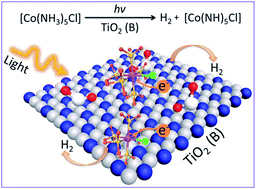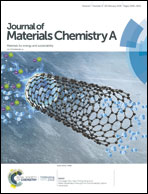Enhancement of photocatalytic H2 production by metal complex electrostatic adsorption on TiO2 (B) nanosheets†
Abstract
The assembly of cocatalysts on a semiconductor is a key way to promote the activity in solar hydrogen production. This process can be realized by anchoring metal complexes which can provide catalytically active sites. Despite the most recent advances, the performances and cycling stability of metal complex/semiconductor composite catalysts are still hindered by their poor contact or linkage. Herein, a series of metal complexes, such as [Co(NH3)5Cl]Cl2, [Ni(NH3)6]Cl2, and [Cu(NH3)4](OH)2, are anchored on TiO2 (B) nanosheets via a facile controllable electrostatic adsorption route. The resultant TiO2 (B) composites exhibit significantly enhanced activity and stability in photocatalytic hydrogen production compared to the blank TiO2 (B) counterpart. The [Co(NH3)5Cl]2+–TiO2 (B) composite achieves a high activity of 3.9 mmol g−1 after 8 h (with a turnover frequency (TOF) of 249 h−1), which is about 57% of that of the benchmark Pt-loaded TiO2 (B) catalyst. Further experimental and theoretical studies confirm that the strong contact between metal complexes with TiO2 (B) can facilitate photoexcited electron transfer and separation, which is responsible for the improved activity. Desorption of hydrogen atoms from ammonium in metal complexes is kinetically favorable and they can accept photoexcited electrons to generate H2. This study can open up a promising pathway to synthesize high-performance metal complex anchored semiconductors by electrostatic adsorption.



 Please wait while we load your content...
Please wait while we load your content...